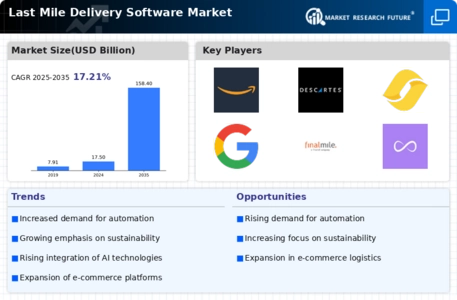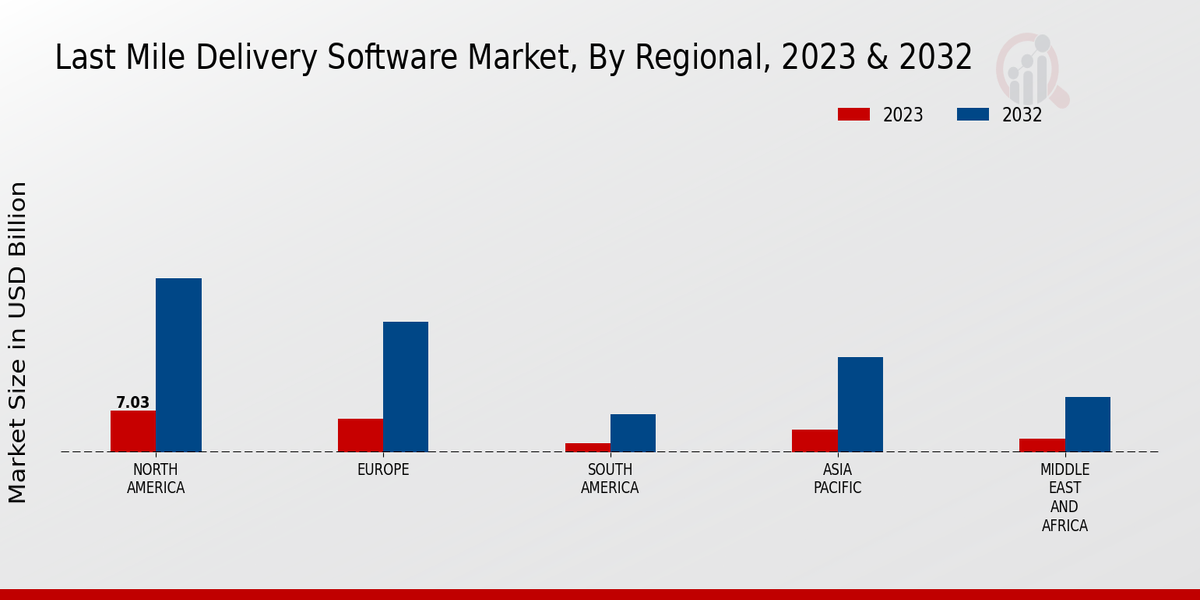Rising E-commerce Demand
The surge in e-commerce activities globally drives the Global Last Mile Delivery Software Market Industry. As consumers increasingly prefer online shopping, the demand for efficient last mile delivery solutions intensifies. In 2024, the market is valued at 17.5 USD Billion, reflecting the growing need for software that optimizes delivery routes and enhances customer satisfaction. Companies are investing in advanced technologies to streamline operations, reduce delivery times, and improve tracking capabilities. This trend is expected to continue, with the market projected to reach 158.4 USD Billion by 2035, indicating a robust growth trajectory fueled by e-commerce expansion.
Market Growth Projections
The Global Last Mile Delivery Software Market Industry is poised for remarkable growth, with projections indicating a market value of 17.5 USD Billion in 2024 and an anticipated increase to 158.4 USD Billion by 2035. This growth trajectory reflects a compound annual growth rate (CAGR) of 22.18% from 2025 to 2035. Such figures underscore the increasing reliance on efficient last mile delivery solutions across various sectors, driven by factors such as e-commerce expansion, technological advancements, and changing consumer expectations. The market's potential suggests a dynamic landscape where innovation and adaptability will be key to success.
Sustainability Initiatives
Sustainability initiatives are increasingly shaping the Global Last Mile Delivery Software Market Industry. As environmental concerns rise, companies are seeking ways to reduce their carbon footprints and implement eco-friendly delivery practices. This trend encourages the development of software solutions that optimize delivery routes, minimize fuel consumption, and promote the use of electric vehicles. Businesses that prioritize sustainability not only enhance their brand image but also align with consumer preferences for environmentally responsible practices. The growing emphasis on sustainability is expected to influence market dynamics, leading to the adoption of innovative last mile delivery software that supports these initiatives.
Technological Advancements
Technological innovations play a crucial role in shaping the Global Last Mile Delivery Software Market Industry. The integration of artificial intelligence, machine learning, and real-time data analytics enhances delivery efficiency and accuracy. These technologies enable companies to predict demand patterns, optimize routes, and manage resources effectively. As businesses adopt these advanced solutions, they can significantly reduce operational costs and improve service levels. The ongoing evolution of technology suggests that the market will experience substantial growth, with a projected CAGR of 22.18% from 2025 to 2035, as organizations seek to leverage these advancements for competitive advantage.
Urbanization and Population Growth
Urbanization and population growth are pivotal factors influencing the Global Last Mile Delivery Software Market Industry. As more people migrate to urban areas, the demand for efficient delivery services escalates. Urban environments present unique challenges, such as traffic congestion and limited access, necessitating sophisticated software solutions to navigate these complexities. The increasing urban population is expected to drive the market's expansion, as companies strive to meet the rising expectations for timely and reliable deliveries. This demographic shift indicates a sustained demand for innovative last mile delivery software, further propelling market growth in the coming years.
Consumer Expectations for Fast Delivery
Consumer expectations for rapid delivery services significantly impact the Global Last Mile Delivery Software Market Industry. Today's consumers prioritize speed and convenience, often expecting same-day or next-day delivery options. This shift in consumer behavior compels businesses to adopt advanced last mile delivery software that can meet these demands efficiently. Companies that fail to adapt may risk losing market share to competitors who can provide faster services. As a result, the market is likely to witness continued investment in technologies that enhance delivery speed and reliability, further driving growth in this sector.


















